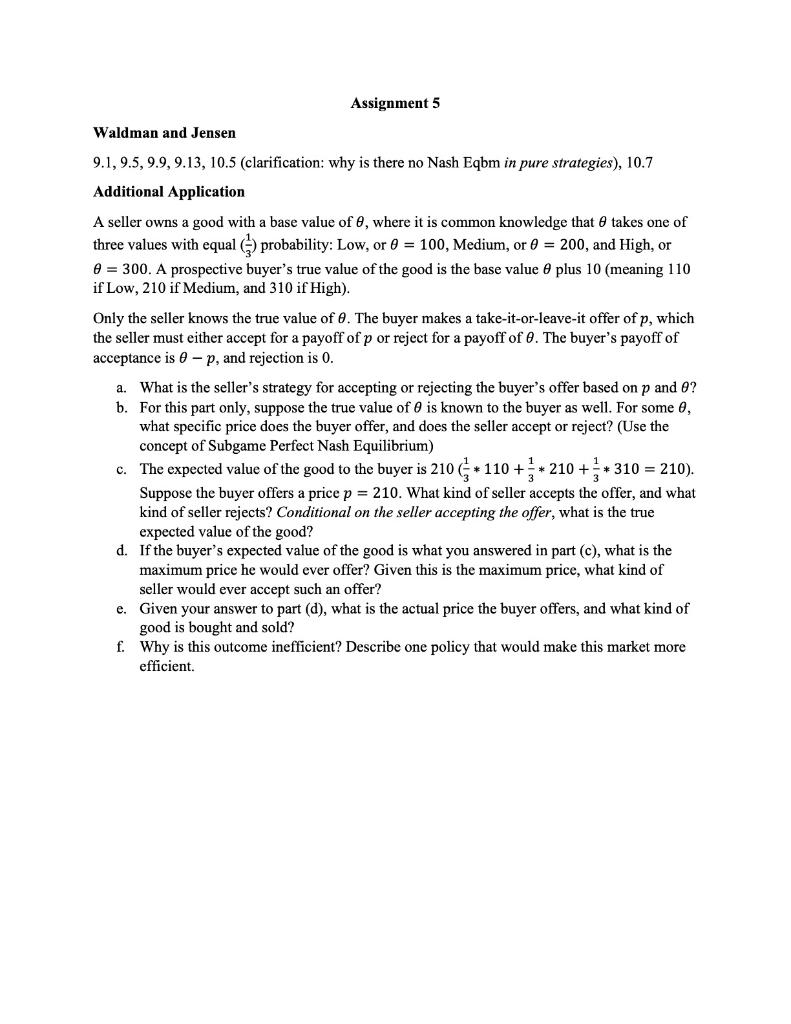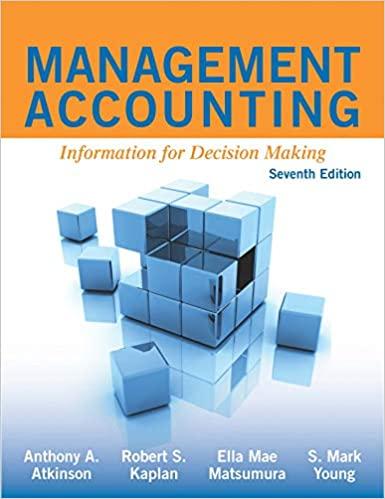
Assignment 5 Waldman and Jensen 9.1, 9.5, 9.9,9.13, 10.5 (clarification: why is there no Nash Eqbm in pure strategies), 10.7 Additional Application A seller owns a good with a base value of , where it is common knowledge that takes one of three values with equal () probability: Low, or 0 = 100, Medium, or 0 = 200, and High, or O = 300. A prospective buyer's true value of the good is the base value & plus 10 (meaning 110 if Low, 210 if Medium, and 310 if High). Only the seller knows the true value of 0. The buyer makes a take-it-or-leave-it offer of p, which the seller must either accept for a payoff of p or reject for a payoff of 0. The buyer's payoff of acceptance is e-p, and rejection is 0. a. What is the seller's strategy for accepting or rejecting the buyer's offer based on p and O? b. For this part only, suppose the true value of 0 is known to the buyer as well. For some 0, what specific price does the buyer offer, and does the seller accept or reject? (Use the concept of Subgame Perfect Nash Equilibrium) c. The expected value of the good to the buyer is 210 (+ 110 + +210 +1+310 = 210). Suppose the buyer offers a price p = 210. What kind of seller accepts the offer, and what kind of seller rejects? Conditional on the seller accepting the offer, what is the true expected value of the good? d. If the buyer's expected value of the good is what you answered in part (c), what is the maximum price he would ever offer? Given this is the maximum price, what kind of seller would ever accept such an offer? e. Given your answer to part (d), what is the actual price the buyer offers, and what kind of good is bought and sold? f. Why is this outcome inefficient? Describe one policy that would make this market more efficient. Assignment 5 Waldman and Jensen 9.1, 9.5, 9.9,9.13, 10.5 (clarification: why is there no Nash Eqbm in pure strategies), 10.7 Additional Application A seller owns a good with a base value of , where it is common knowledge that takes one of three values with equal () probability: Low, or 0 = 100, Medium, or 0 = 200, and High, or O = 300. A prospective buyer's true value of the good is the base value & plus 10 (meaning 110 if Low, 210 if Medium, and 310 if High). Only the seller knows the true value of 0. The buyer makes a take-it-or-leave-it offer of p, which the seller must either accept for a payoff of p or reject for a payoff of 0. The buyer's payoff of acceptance is e-p, and rejection is 0. a. What is the seller's strategy for accepting or rejecting the buyer's offer based on p and O? b. For this part only, suppose the true value of 0 is known to the buyer as well. For some 0, what specific price does the buyer offer, and does the seller accept or reject? (Use the concept of Subgame Perfect Nash Equilibrium) c. The expected value of the good to the buyer is 210 (+ 110 + +210 +1+310 = 210). Suppose the buyer offers a price p = 210. What kind of seller accepts the offer, and what kind of seller rejects? Conditional on the seller accepting the offer, what is the true expected value of the good? d. If the buyer's expected value of the good is what you answered in part (c), what is the maximum price he would ever offer? Given this is the maximum price, what kind of seller would ever accept such an offer? e. Given your answer to part (d), what is the actual price the buyer offers, and what kind of good is bought and sold? f. Why is this outcome inefficient? Describe one policy that would make this market more efficient







